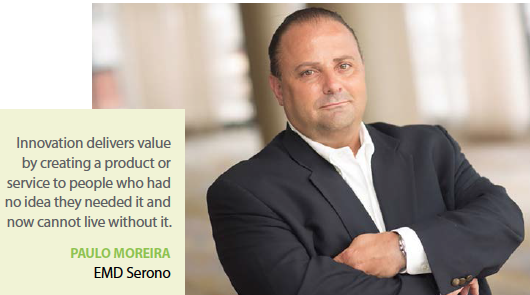 Talk of innovation is in the air. No matter where one turns there are reports, studies, conferences, etc. dedicated to the topic — and for good reason. Innovation has been at the center of the life-sciences industry since the beginning, but there is a renewed focus on creating value and developing a culture of innovation today. Companies — large and small — are looking to derive as much value as possible from their investment and defining innovation in their own way.
Talk of innovation is in the air. No matter where one turns there are reports, studies, conferences, etc. dedicated to the topic — and for good reason. Innovation has been at the center of the life-sciences industry since the beginning, but there is a renewed focus on creating value and developing a culture of innovation today. Companies — large and small — are looking to derive as much value as possible from their investment and defining innovation in their own way.
“Our definition of innovation is generating something new or novel that creates new value for the enterprise," says Shideh Sedgh Bina, co-founding partner of Insigniam. “It’s any kind of new value, not just in what a company makes but how it makes it, how it makes it available, and every other piece that goes into the system."
Mike Rea, CEO of IDEA Pharma, concurs that innovation is about delivering value, and from his perspective it’s about delivering value to patients.
“In our industry, innovation is essentially what companies can bring to patients," he explains. “A lot of people talk about innovation, but it’s unclear what they mean, and I think in many cases, what they mean is invention. There’s a lot of real inventiveness about our industry,  but this doesn’t always deliver value, products sit on the shelf or die somewhere in the pipeline. We don’t regard that as innovation; we regard that as invention, which is nice but the two should go hand-in-hand.
but this doesn’t always deliver value, products sit on the shelf or die somewhere in the pipeline. We don’t regard that as innovation; we regard that as invention, which is nice but the two should go hand-in-hand.
“The companies that are rising at the moment are the ones that are developing and launching products against a real unmet need," Mr. Rea continues. “Companies such as Gilead, for example, are challenging the commercial model. I think the value is competitiveness. The new competition in our industry is significant and I think that the freshness of a portfolio means that companies need to think harder about the products in their pipeline and what they are going to launch and how they are going to launch them."
Recently, Harvard Business Review (HBR) interviewed more than 130 executives from more than 30 multinational companies in North America and Europe. They also surveyed 4,000 nonexecutive employees in 15 multinational companies, and analyzed innovation effectiveness in 120 new-product-development projects and 100 corporate venturing units. The results demonstrated that the innovation value chain view presents innovation as a sequential, three-phase process that involves idea generation, idea development, and the diffusion of developed concepts. Across all the phases, managers must perform six critical tasks — internal sourcing, cross-unit sourcing, external sourcing, selection, development, and companywide spread of the idea. Each is a link in the chain. Along the innovation value chain, there may be one or more activities that a company excels in — the firm’s strongest links. Conversely, there may be one or more activities that a company struggles with — the firm’s weakest links. Furthermore, HBR reports that to improve innovation, executives need to view the process of transforming ideas into commercial outputs as an integrated flow. The first of the three phases in the chain is to generate ideas; this can happen inside a unit, across units in a company, or outside the firm. The second phase is to convert ideas, or, more specifically, select ideas for funding and developing them into products or practices. The third is to diffuse those products and practices.
The Value Prop of Pharma Innovation
 To Mr. Rea’s point, many companies are embracing innovation as way to deliver value to patients. One such company, Johnson & Johnson Innovation LLC recently opened JLABS @ TMC, a 34,000-square-foot life-sciences incubator to provide entrepreneurs with shared lab space, private offices, and modular laboratory suites, as well as state-of-the-art equipment and value-added operational, education, and business services. The new JLABS facility can accommodate up to 50 start ups, and opened with 21 companies that represent a range of disciplines and geographies. This first “class" of resident startups includes the four winners of the JLABS Quick Fire Challenge, which awards promising early-stage innovation companies with residency at the facility.
To Mr. Rea’s point, many companies are embracing innovation as way to deliver value to patients. One such company, Johnson & Johnson Innovation LLC recently opened JLABS @ TMC, a 34,000-square-foot life-sciences incubator to provide entrepreneurs with shared lab space, private offices, and modular laboratory suites, as well as state-of-the-art equipment and value-added operational, education, and business services. The new JLABS facility can accommodate up to 50 start ups, and opened with 21 companies that represent a range of disciplines and geographies. This first “class" of resident startups includes the four winners of the JLABS Quick Fire Challenge, which awards promising early-stage innovation companies with residency at the facility.
JLABS @ TMC builds on the successful JLABS model and is the fifth JLABS facility to open in the United States. The Houston site is the first to open with a medical device prototype lab, featuring a 3D printer, which will provide entrepreneurs access to highly specialized tools, as well as skills building programs to design and develop smart health technologies.
“For us at Johnson & Johnson, innovation transforms lives," says Melinda Richter, head, Johnson & Johnson Innovation JLABS. “Our commitment is to improve the health and wellness of people all over the world and to do that, we have to create a safe and supported space for innovators, whether inside or out of the company, to translate new ideas into real commercial opportunities that can reach the people who need it. Our goal, therefore, is to inspire, to empower, and to enable genius."
Brent Saunders, CEO and president of Allergan, agrees that innovation is critical to any organization committed to delivering long-term value — for patients, for medical professionals, for shareholders, and for society.
 “But a commitment to innovation begins at the top," he says. “Organizations with a strong commitment to innovation are more collaborative and open to new perspectives that incubate and deliver new ideas. This approach, which at Allergan we call open science, allows the best ideas to rise to the top, no matter their origins, and puts us in a stronger position to deliver our ultimate goal — new medicines that change lives."
“But a commitment to innovation begins at the top," he says. “Organizations with a strong commitment to innovation are more collaborative and open to new perspectives that incubate and deliver new ideas. This approach, which at Allergan we call open science, allows the best ideas to rise to the top, no matter their origins, and puts us in a stronger position to deliver our ultimate goal — new medicines that change lives."
Quite simply, Paulo Moreira, VP, head, global clinical operations, external innovation, at EMD Serono, believes innovation delivers value by creating a product or service to people who had no idea they needed it and now cannot live without it.
“Innovation is not prescriptive," he adds. “Innovation is a state of mind; it’s an attitude that is embedded so deeply, it becomes the culture of the organization. However, many companies do not succeed because they choose to tackle the challenge of innovation as a process that they need to create."
At the same time, it’s only through innovation that pharma can address the major issues it is facing, including increasing drug development costs and less robust pipelines, says Keith Murphy, chairman and CEO, Organovo.
“We have to reduce late-stage drug failures and safely expedite the right molecules through development," he says. “Innovations that improve models of human biology offer greater predictability of drug safety and efficacy before clinical trials, which leads to greater value to pharma companies and the patients they serve. Pharma R&D teams, working in concert with key innovation partners with next level disease modeling capabilities, can reshape the drug development process to improve success rates and decrease timelines and costs."
Bringing in new ideas or opportunities that can add growth to the business is one obvious benefit of innovation says Wendy Mayer, VP, worldwide innovation, Pfizer, adding that there is another broader value to the business that is often overlooked.
 “Innovation can create a culture and environment that excites and empowers colleagues about the contributions they can make to the business, and enables them to get involved with new concepts that can transform the business," she says. (PV)
“Innovation can create a culture and environment that excites and empowers colleagues about the contributions they can make to the business, and enables them to get involved with new concepts that can transform the business," she says. (PV)


















